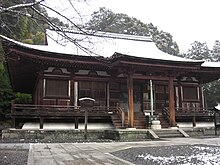Chōkyū-ji
The Chōkyū-ji ( Japanese 長弓 寺 ) is a temple of the Shingon direction of Buddhism in the city of Ikoma in Nara Prefecture .
history
There are various explanations for the history of the origin of the temple. According to their own tradition ( 長弓 寺 縁 起 , Chōkyū-ji engi ), Emperor Shōmu was hunting in the area when he called his new bow "True Bow" ( 真弓 , Mayumi ). The name of a mountain in the area, Mayumi-yama, and the name "Long Arch Temple", Chōkyū-ji in Sino-Japanese, is derived from this. Parts of the saint figure venerated in the temple are said to be made from arches, the rest is buried under a hill. This "True Arch Hill" ( 真弓 塚 , Mayumizuka ) is 1 km away from the temple in an inhabited mountain area.
The temple, planned at the request of Emperor Shōmu, is said to have been built by priest Gyōki in 730. In the Enryaku period (782–806) Fujiwara no Yoshitsugu ( 藤原 良 継 ; 716–777) expanded the temple, and it flourished in the Middle Ages. But when Yamana Sozen ( 山 名 宗 全 ; 1404–1473) lost his life at the end of the Onin turmoil in 1473 , the temple treasures were also lost. One hundred years later, in 1577, Oda Nobunaga confiscated large areas of the temple grounds.
The attachment
The main hall ( 本 堂 , Hondō ) is registered as a national treasure. The inscription in black ink found on the ceiling indicates the year of construction 1279. The width of the hall is 5 ken, that is, 5 pillar spacings (15 m in total) and the depth 6 ken, around 14.6 m. The temple has a hipped foot roof with a canopy over the entrance and is a good example of the Japanese style .
An eleven-headed Kannon is venerated in the temple and is housed in a black lacquered shrine ( 黒 漆 厨子 , Kuro-urushi zushi ). Both are registered as important cultural assets. It is a saint figure that is only open to the public for a limited period in January. It comes from the Heian period , is carved from wood and is four feet tall.
Below the main hall at the foot of the stone staircase is a stone hand basin ( 手 水 鉢 , Chōzu-bachi ) on the left , which was big enough to take a steam bath in in ancient times.
literature
- Nara-ken kotogakko-kyoka token kenkyu-kyokai rekishi bukai (Ed.): Chōkyū-ji . In: Nara-ken no rekishi sampo (jo). Yamakawa Shuppan, 2010. ISBN 978-4-634-24629-4 .
Web links
Coordinates: 34 ° 43 ′ 6.8 " N , 135 ° 43 ′ 35.7" E



